
STORMS
WHY DOES STORMS
MATTER?
-
Storms can wreak havoc on societies and the natural environment, causing fatalities, livestock loss, crop destruction, infrastructure damage, disruption of transportation, power outages, lightning-induced wildfires, coastal and soil erosion, contamination of water resources, displacement of communities, disruption of essential services and commerce, increased insurance costs, and long-term mental health effects on survivors. These are just a few of their impacts. [link]
-
Global warming is amplifying the energy in the atmosphere, leading to a modification of the storm regimes that could likely result in an increase in their frequency and magnitude. This is alarming, as the severe impacts of storms are also anticipated to escalate. [link]
-
The complex challenges storms pose to human and environmental well-being necessitate comprehensive actions for effective mitigation. Prevention and policy measures, including early warning systems, resilient infrastructure, and sustainable land-use planning, play a crucial role in reducing vulnerability. Integrating scientific knowledge and community engagement in well-defined policies is key to enhancing society's resilience to storm-related impacts. [link]
WHY A NEXUS APPROACH?
The well-being and stability of human environments, encompassing health, economy, and safety, hinge upon crops, resources, and infrastructure that can endure and recover from natural hazards, including extreme storms. The escalating energy levels in the atmosphere, attributed to global warming, are anticipated to elevate the frequency and intensity of storms worldwide. Storms are characterized as disturbances in the atmosphere and, thus, can manifest as a combination of heavy precipitation, strong winds, and other severe weather conditions. There are various types of storms, each with distinct impacts. Thunderstorms: These are marked by excessive thunder, strong winds, and heavy rain, posing risks to public health and safety by triggering flash flooding or lightning-induced fires. Hailstorms: During these storms, hailstones and ice lumps form and precipitate, causing damage to crops, buildings, and vehicles. Ice Storms: Freezing rain during ice storms results in the formation of ice layers on roads, trees, and power lines, leading to hazardous driving conditions and power outages. Blizzards: Combining strong winds with heavy snowfall, blizzards can result in deadly exposure to extreme cold, disrupt traffic, and impact aviation. Tornadoes: These twisting, violent, funnel-shaped windstorms cause extensive building damage on a local scale. Tropical Cyclones: Massive cyclones, formed over warm ocean waters, can cause devastating coastal flooding, displacement of humans and animals, infrastructure damage, and losses in crops and livestock. Dust Storms: Resulting from strong winds and arid conditions, dust storms can exacerbate health conditions such as asthma, erode fertile soil, harm plants, contaminate water, and disrupt daily activities due to reduced visibility.
Clearly, the intricate challenges posed by storms necessitate the adoption of a nexus approach to effectively mitigate their impacts. This includes: (1) The development of multidisciplinary scientific knowledge and tools in geosciences, engineering, and social sciences. (2) Integrated planning that acknowledges the interconnections between different sectors and promotes a coordinated response among government agencies, communities, and businesses. (3) The implementation of advanced early warning systems to facilitate proactive measures for reducing vulnerabilities in the face of impending storms. (4) Strengthening infrastructure and enhancing agricultural resilience through adaptive design and climate-change integration, which encompasses the promotion of farming practices that are resilient to storms. (5) Actively involving and engaging communities in the planning and decision-making processes to enhance local resilience ensuring alignment with specific needs and exposures unique to each community. (6) Crafting policies that span different sectors and account for the challenges posed by global warming. This strategic development ensures a cohesive and effective response to storm-related impacts. And (7), allocating resources for research and innovation to urgently develop solutions that address the pressing challenges posed by global warming.
AID TOOLS
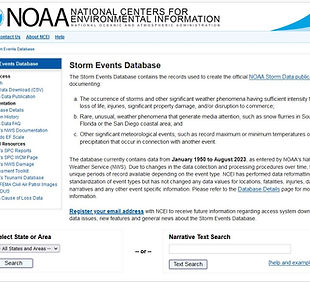
Storm Events Database
The Storm Events Database contains the records used to create the official NOAA Storm Data publication, documenting: (1) The occurrence of storms and other significant weather phenomena having sufficient intensity to cause loss of life, injuries, significant property damage, and/or disruption to commerce; (2) Rare, unusual, weather phenomena that generate media attention, such as snow flurries in South Florida or the San Diego coastal area; and (3) Other significant meteorological events, such as record maximum or minimum temperatures or precipitation that occur in connection with another event.
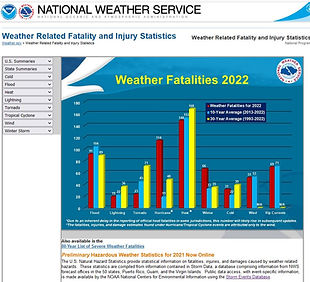
Weather Related Fatality and Injury Statistics
The U.S. Natural Hazard Statistics provides statistical information on fatalities, injuries, and damages caused by weather-related hazards. These statistics are compiled from information contained in Storm Data, a database comprising information from NWS forecast offices in the 50 states, Puerto Rico, Guam, and the Virgin Islands.
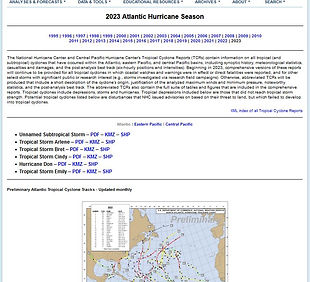
National Hurricane Center and Central Pacific Hurricane Center
The National Hurricane Center and Central Pacific Hurricane Center's Tropical Cyclone Reports (TCRs) contain information on all tropical (and subtropical) cyclones that have occurred within the Atlantic, eastern Pacific, and central Pacific basins, including synoptic history, meteorological statistics, casualties and damages, and the post-analysis best track. Beginning in 2023, comprehensive versions of these reports will continue to be provided for all tropical cyclones in which coastal watches and warnings were in effect or direct fatalities were reported, and for other select storms with significant public or research interest (e.g., storms investigated via research field campaigns).

CoSMoS | Complete Stochastic Modelling Solution
CoSMoS is a leading and widely downloaded R package for stochastic simulation. Designed with the end user in mind, CoSMoS makes univariate, multivariate, or random field simulations easy allowing users to create and explore the variability of synthetic storms.
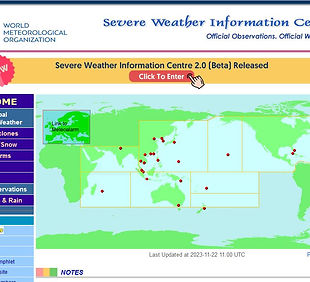
The information in this World Meteorological Organization (WMO) website is based on advisories issued by Regional Specialized Meteorological Centres (RSMCs) and Tropical Cyclone Warning Centres (TCWCs), and official warnings issued by National Meteorological and Hydrological Services (NMHSs) for their respective countries or regions.
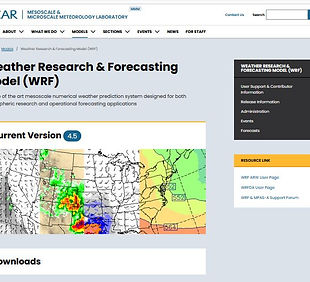
Weather Research & Forecasting Model (WRF)
The Weather Research and Forecasting (WRF) Model is a state-of-the-art mesoscale numerical weather prediction system designed for both atmospheric research and operational forecasting applications. It features two dynamical cores, a data assimilation system, and a software architecture supporting parallel computation and system extensibility. The model serves a wide range of meteorological applications across scales from tens of meters to thousands of kilometers.
Get to Know AID Members
You can consult with the AID group leader or any members for your regional, national, and global datasets, tools, and analytics projects and questions.
Publications

Sustainability Nexus AID: Storms
This paper presents the UNU Sustainability Nexus AID Programme’s Storms Module, which provides tools for storm monitoring, modeling, and preparedness. It also highlights both the potential and the limitations of emerging AI technologies in enhancing storm resilience and supporting sustainable development.









cr_JPG.jpg)





